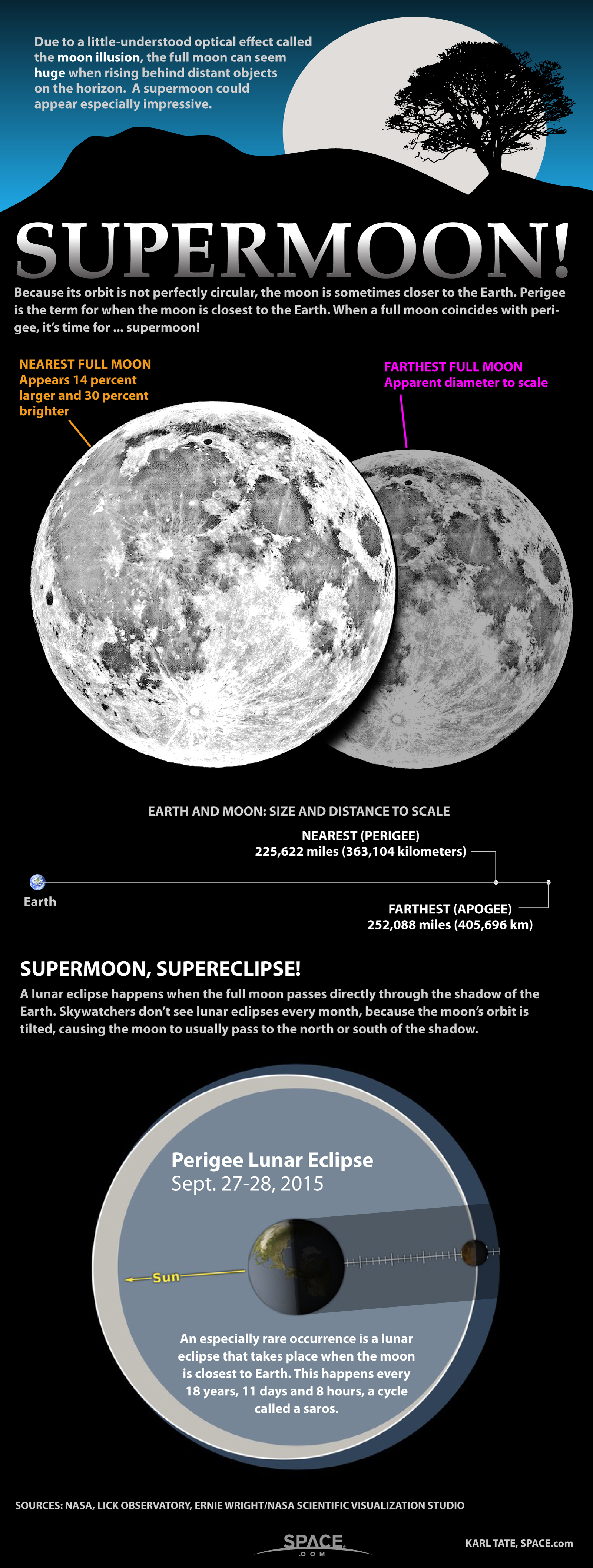Supermoon 2019: When and How to See the Supermoon Trifecta
This year skywatchers will get to witness three supermoons in a row on Jan. 21, Feb. 19 and March 20.
A supermoon occurs when a full moon coincides with the moon's perigee, or the point in its elliptical orbit at which it is closest to Earth. This makes the moon appear up to 14 percent larger and 30 percent brighter than usual.
The first supermoon of 2019 was the Super Blood Wolf Moon on Jan. 20-21, which coincided with a total lunar eclipse, also known as a "blood moon." A second supermoon of 2019 will follow on Tuesday, Feb. 19, during the Snow Moon, which will be the closest full moon of the year. Then on March 20 at 9:43 p.m. EDT (0143 GMT March 21) , the Worm Moon will reach full phase about 29 hours after the moon reaches perigee. ['Supermoon' Photos: The Closest Full Moon Until 2034 in Pictures]
What is a supermoon?
While astronomers have traditionally defined a supermoon as being the single closest full moon in a year, that definition has gained some wiggle room in recent years. By the original definition of a supermoon, the most "super" supermoon of 2019 will be on Feb. 19, when the moon will reach perigee about 6 hours before it is officially full.
The moon's average distance from Earth is 238,855 miles (384,400 kilometers), but its orbit isn't perfectly circular, so that distance varies a small amount. When the moon reaches its closest perigee of the year on Feb. 19, it will be 221,681 miles (356,761 km) away from Earth.
Supermoons don't happen every month because the moon's orbit changes orientation as the Earth goes around the sun. So, the long axis of the moon's elliptical path around the Earth points in different directions, meaning that a full (or new) moon won't always happen at apogee or perigee.
When to see the supermoon
The first supermoon of 2019 happened on Jan. 21, when the moon reached its fullest phase at 12:16 a.m. EST (0516 GMT). That full moon peaked 14 hours before the moon was actually closest to Earth; it reached perigee on Jan. 21 at 2:59 p.m. EST (1959 GMT). You can see Space.com's full coverage of the Super Blood Wolf Moon Eclipse here.
Breaking space news, the latest updates on rocket launches, skywatching events and more!
When the Snow Moon becomes officially full on Feb. 19 at 10:53 a.m. EST (1553 GMT), it will be about six hours past perigee. The moon will be at its closest at 4:07 a.m. EST (0907 GMT) on Feb. 19. Although the moon is officially "super" on Feb. 19, it will still look pretty full (and super!) to the casual observer the night before and after.
For skywatchers in New York City, the Snow Moon will rise on Feb. 19 at 5:46 p.m. and set the next morning at 7:35 a.m. local time. To figure out when the moon will rise and set from your location, check out this moonrise and moonset calculator at timeanddate.com.
The third and final supermoon of the year will happen during the Worm Moon, which reaches full phase on March 20 at 9:43 p.m. EST (0143 GMT on March 21). It will become full about a day and 6 hours before reaching perigee, which happens on March 19 at 3:48 p.m. EST (1948 GMT). This supermoon happens to coincide with the vernal equinox, which marks the first day of spring in the Northern Hemisphere and the first day of autumn in the Southern Hemisphere.
Editor's note: If you captured an amazing skywatching photo or video and would like to share it with Space.com for a story or gallery, send images and comments to spacephotos@space.com.
Email Hanneke Weitering at hweitering@space.com or follow her @hannekescience. Follow us on Twitter @Spacedotcom and on Facebook. Original article on Space.com.

Hanneke Weitering is a multimedia journalist in the Pacific Northwest reporting on the future of aviation at FutureFlight.aero and Aviation International News and was previously the Editor for Spaceflight and Astronomy news here at Space.com. As an editor with over 10 years of experience in science journalism she has previously written for Scholastic Classroom Magazines, MedPage Today and The Joint Institute for Computational Sciences at Oak Ridge National Laboratory. After studying physics at the University of Tennessee in her hometown of Knoxville, she earned her graduate degree in Science, Health and Environmental Reporting (SHERP) from New York University. Hanneke joined the Space.com team in 2016 as a staff writer and producer, covering topics including spaceflight and astronomy. She currently lives in Seattle, home of the Space Needle, with her cat and two snakes. In her spare time, Hanneke enjoys exploring the Rocky Mountains, basking in nature and looking for dark skies to gaze at the cosmos.

